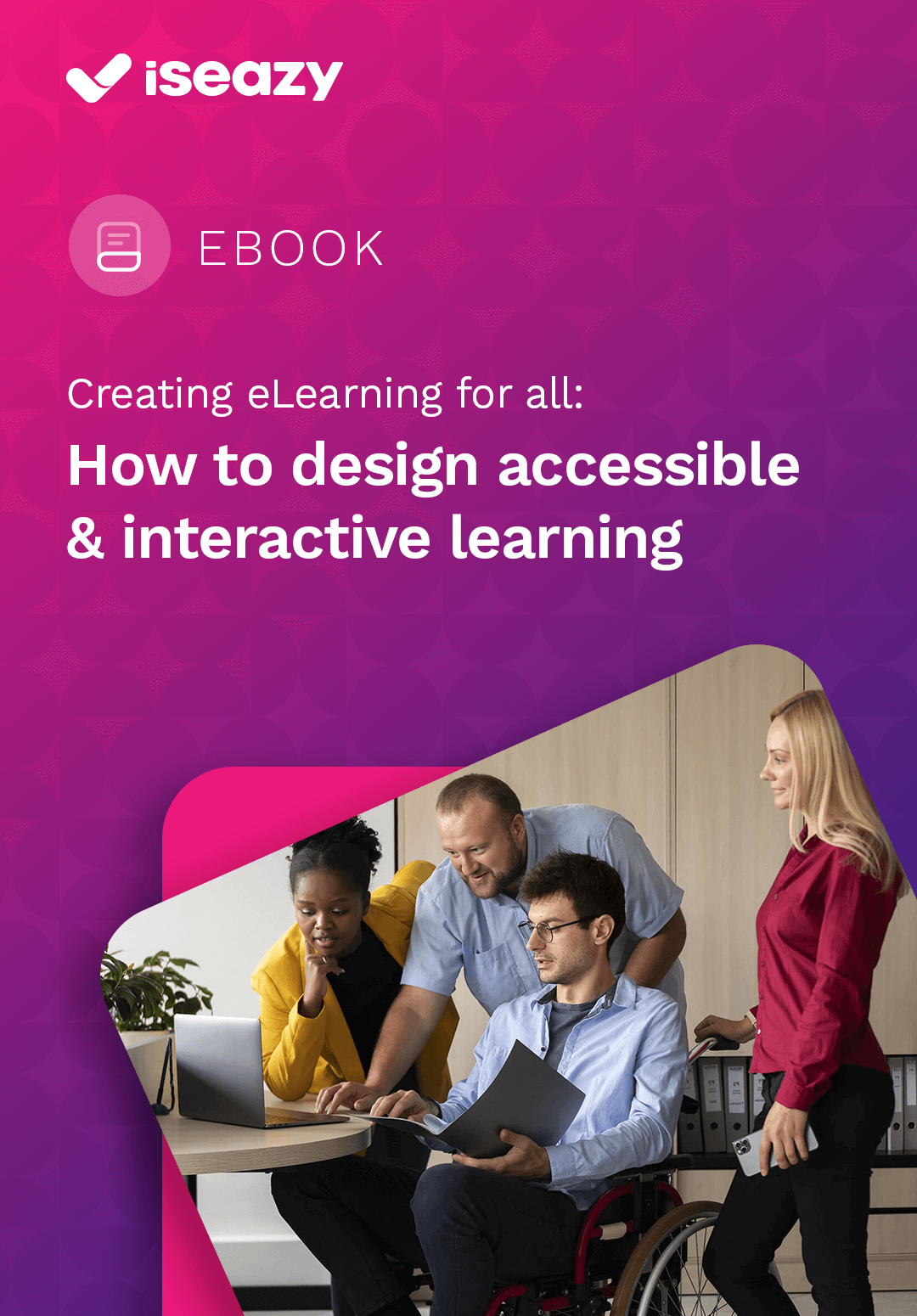Effortless Engagement: Accessible Interactive Elements
Do you want to know what accessible interactive elements you can include in your training to make it more dynamic and effective? Below, we offer a complete list of interactives and the basic problems and criteria that you should be aware of when using them in your accessible eLearning courses.

Basic Elements
- Images: Images are a very useful resource which complete and contextualize information presented in a text. Presenting them in the form of a gallery can also help to explain more complex processes in, for example, a step-by-step format.
- Cards: An interactive element with a multitude of pedagogical uses. You can put information on both sides so that the student discovers hidden content on the back of the card when they activate each one.
- Links: These serve to link your content with other external resources.
- Downloads: This element allows you to integrate additional external content within your courses so that students can download it. This could include guides, reports, or PowerPoint presentations.
Problems With This Type Of Interactive
People with blindness or visual disabilities cannot enjoy image resources. Furthermore, the use of interactive elements with information hidden behind an animation can make it difficult to consume for those using screen readers.
Accessible Version
Images with relevant content must be accompanied by an alternative text that will allow students who use assistive technology to access the information they need. In addition, you must incorporate the content of interactives such as cards and galleries in such a way that all users can locate and access the information they contain. On the other hand, if you wish to include files for downloading, the links must disclose relevant information on the type of document in question, as well as be accessible.
Multimedia Elements
- Audios: Audio is perfect for streaming relevant or complementary information in your e-learning courses. You can play with the content, adding podcasts or interviews, to integrate different points of view that will facilitate the understanding of the training content.
- Videos: Videos are one of the resources most valued by students. They allow you to offer your audience a greater quantity of information in a more dynamic way that can also facilitate storytelling. If the video is interactive, it will also help to reinforce concepts and ideas through student participation.
- Voice-over: Voice-overs can be a very interesting element to include in your training; for example, to smoothly introduce the content that is going to be covered throughout the course.
Problems With This Type Of Interactive
In an accessible course, you should generally avoid elements that play automatically. In addition, in the case of audio and video, it is important to take into account all those students who have some type of visual or hearing disability.
Accessible Version
Just like images, audio, and video elements must be accompanied by alternative content that allows students who use assistive technology to access the information they represent. For example, videos must be accompanied by subtitles, transcripts, and audio descriptions. It is also necessary for the student to be able to control the content via a keyboard.
Advanced Interactivity
- Points of interest: Points of interest or hot spots are interactive elements that allow you to highlight important parts of an image and access complementary information with just one click.
- Infographics and graphs: Infographics and graphs are visual representations of text, data, or complex graphics. They make your content more dynamic by presenting the data in a different way.
Problems With This Type Of Interactive
The main problem with the use of this type of interactive in accessible eLearning courses lies in the difficulty of interpreting the visual information they contain.
Accessible Version
In this case, it is necessary to include a description of the scene and provide quick and direct access to the data contained in the graphs and infographics.
Exercises
- ABC exercise: ABC exercises are very useful resources. Through a series of questions, users will have the chance to test their knowledge by selecting the correct answer from a series of options.
- Arrange exercise: This type of exercises are self-training activities that help reinforce learning. They allow the student to test their knowledge by grouping concepts into their corresponding categories.
- Match exercise: This interactive is used to connect concepts from one group to another. Students must click on a concept from the first group and then select another concept from the opposite group that they think is related.
- Sort exercise: Sorting exercises are perfect for understanding processes. Students will have a list of options that they must arrange according to the order they consider correct.
Fill in the blanks exercise: In this exercise, the student must fill in the missing parts of a text through drop-down menus with different options.
Problems With This Type Of Interactive
Beyond including complex interactions and mouse gestures – such as drag & drop – this type of interactive resource often causes focus management problems and includes elements that are too small for some users to interact with. In addition, when it is necessary for the student to expand the text, this can result in a loss of structure and a poor display of the information on screen.
Accessible Version
Including this type of resource in your accessible eLearning training involves redesigning its user experience. You will need to include alternatives to drag & drop interactions, good focus management features for students using keyboard navigation, alternative text for images, and clear instructions to ensure students interact correctly with them. Also, remember not to give exercise feedback that only uses color to signify right or wrong – use other means such as an explanatory message.
Along with exercises, some authoring tools allow you to include games in your eLearning courses to encourage engagement and increase the effectiveness of the training.
Conclusion
As you can see, it is possible to create eLearning courses that are both interactive and accessible. You just need to take into account all the criteria included in the WCAG when configuring your accessible interactive elements. To simplify this task, look for an authoring tool that offers an automatically accessible solution.
Download the eBook Creating eLearning For All: How To Design Accessible And Interactive Learning today to discover how to design accessible learning experiences that are engaging, personalized, and memorable for every member of your team. You can also join the webinar to overcome the most common accessible eLearning obstacles.










